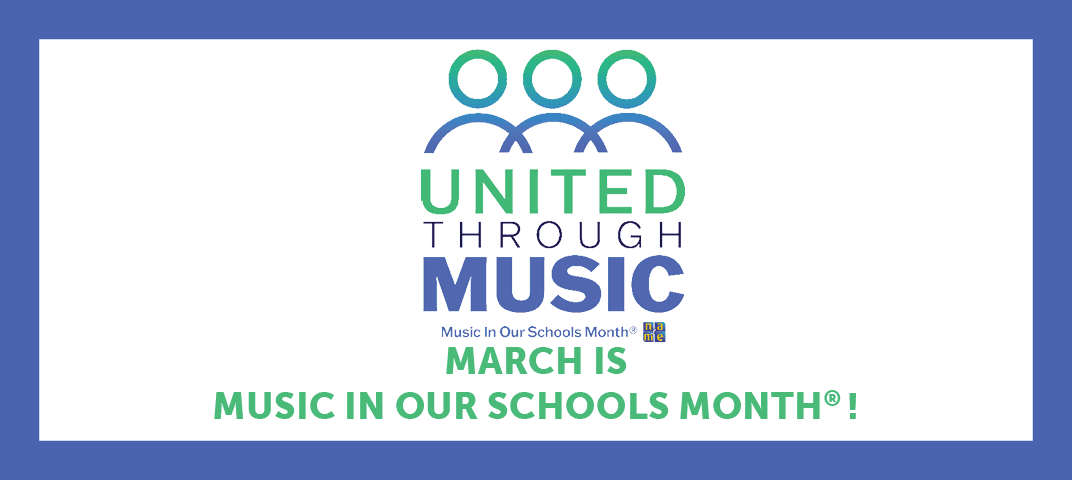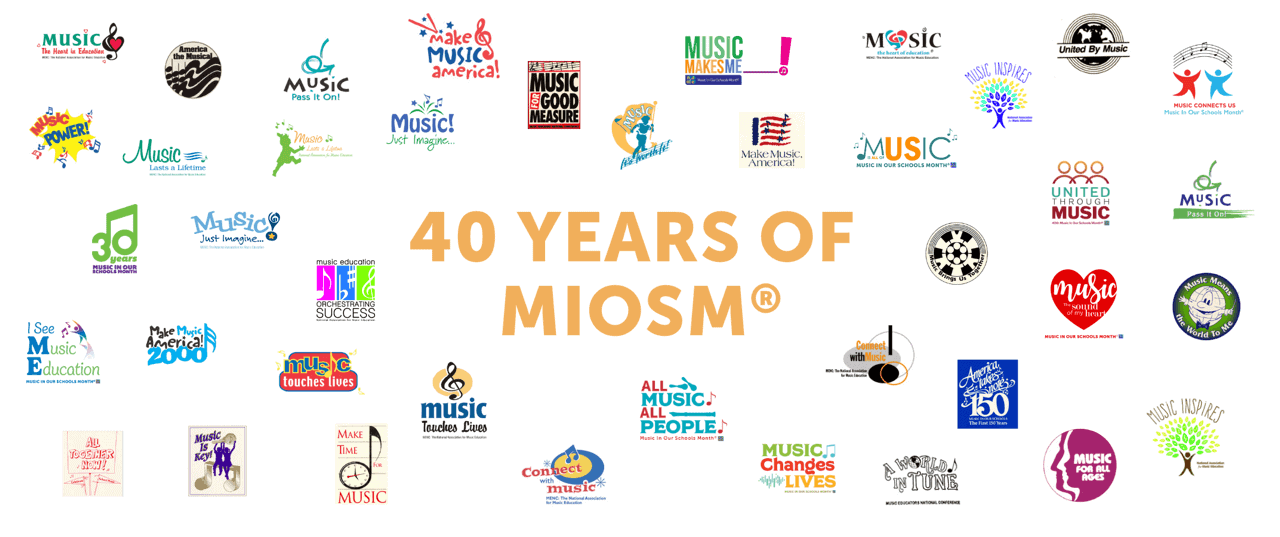Led by the National Association for Music Education (NAfME), music educators and students throughout the United States and overseas are demonstrating this March the powerful role a quality music program plays in the lives of young people. From Music In Our Schools Month® (MIOSM®) concerts at schools, in the community, or even at the state capitol, to state proclamations and visits to legislators, NAfME’s annual event raises awareness about the need for quality music programs for all students.
There will be an opportunity to “ . . . communicate the purposes and processes of music education, as well as demonstrate results. By doing so, it will encourage support for the arts in education.”
2015 messaging? No, that was the description of NAfME’s first national Music In Our Schools Day on March 13, 1975. Music In Our Schools Month began as a single statewide Advocacy Day and celebration in New York on March 14, 1973, and grew over the decades to become a month-long celebration of school music in 1985. The celebration lengthened as teachers asked for more time to showcase their music programs.
An article in the November 1973 issue of the Association’s publication, Music Educators Journal, notes that the Music In Our Schools project was adopted in the Summer of 1973 by the National Executive Board and the National Assembly of State Presidents of the Music Educators National Conference (MENC). MENC was NAfME’s original name.
The MENC endorsement took place after a presentation to MENC leaders by Willard I. Musser of the New York State School Music Association (NYSSMA). At that time he discussed the scope of the project, its myriad of components, and its successful implementation.
In A History of the New York School Music Association 1932-1975 Musser wrote, “Nowadays new music teaching techniques and concepts are available or being used to educate every child in the [educational] system. The demonstration and exposure of these techniques is one of the important aspects of the Music In Our Schools Project. It . . . points out the need for very specially trained music teachers.”

NAfME's National Music In Our Schools Celebration Attracted Broad Support from the Beginning
After a green light from the Association’s leaders, the Association began plans for the first national Music In Our Schools Day. From its inception, obtaining support from education, arts, and other key groups was considered essential.
Supporters for the MENC’s first national Music In Our Schools Day included:
- National Associations of
- Music Merchants
- American Federation of Teachers
- American Library Association
- American Choral Directors Association
- American Symphony Orchestra
- National School Boards Association
- National Education Association
- Music Industry Council
- National Council of State Supervisors of Music
Leaders from MENC and its federated state associations also recognized that while they were urging national support for music education programs, it would be music teachers in the classroom who would actually take the message into their own communities. To help them do that, the Association offered a variety of resources, from sample press releases teachers could use to ask for media coverage, to suggestions on how to garner support from parents, community members, and teachers of other disciplines, or even their local symphony orchestra.
And from that first celebration another key element of the annual Music In Our Schools observance was seeking a proclamation or a resolution about the importance of school music programs, a practice NAfME still urges music teachers today to pursue for the annual March celebrations.
A New York State of Mind: Music In Our Schools Took Root in the Empire State
On March 14, 1973, New York celebrated the first Music In Our Schools Day (MIOSD). According to the November 1973 issue of NAfME’s publication, Music Educators Journal, the first MIOSD “was sponsored by the New York State of Education Department’s Bureau of Music Education, the New York City Board of Education’s Music Bureau, NYSSMA, and the New York State Council of Administrators of Music Education.”
New York Governor Nelson Rockefeller acknowledged MIOSD with a proclamation that stated: “This observance is designed to bring about a more genuine recognition in New York State of the vital place of music in the educational process. . . . Music is a powerful esthetic force. It brings spirit and joy into the life of every individual. It dignifies the realm of feeling by merging intellect and emotion in the search of a humane way of life. It strengthens international and racial bonds.”
The proclamation also states: “It is fitting for New York to recognize music in our schools as an essential part of the learning process. We must continue to encourage and support this significant art form, which, as it moves more deeply into the core of education, becomes a powerful single channel into the innermost feelings and responses of every child.
“The unique qualities and content of music education dramatically express man’s commitments and insights in all cultures of the world, both past and present, help each child communicate with others and build a sense of self.”
Written by Fredrick Fay Swift, A History of the New York Schools Music Association, 1932-1975 notes that NYSSMA introduced “one of the most innovative programs in the Association’s long history.”
The first celebration also included extensive instruction for teachers on how to garner support for MIOSD. New York teachers received communications tools they could use to attract attention from the media, and in March teachers also held concerts and celebrations throughout New York.
For the first MIOSD, one major event included school ensembles playing and singing throughout Lincoln Center in New York City. NYSSMA Executive Director Steven E. Schopp, recalls participating with his brass ensemble:
“It featured many school music groups, some on stage and some in the many lobbies. It did get good press coverage at the time. I was there as director of the H.B. Thompson Jr. High School Brass Ensemble from Syosset, NY. We performed in one of the lobbies.
It was exciting to perform at Lincoln Center. We didn’t know, of course, that this would be anything other than a onetime event. Much to my chagrin, the program had us listed as the Syosset High School brass ensemble and listed [the Syosset director]. SHS didn’t have a brass ensemble at the time!”
In the 1980s, NYSSMA increased its advocacy efforts in conjunction with Music In Our Schools Month®, and visits to legislators in the state capitol in Albany. NYSSMA leaders visit legislators each year on Joe Sugar day, an event named after the long-time NYSSMA music education advocate. Joe Sugar Day was March 4 this year. And continuing another long-standing tradition, teachers and their student groups are performing in Albany throughout the month of March.
NYSSMA’s latest proclamation signed by Gov. Andrew M. Cuomo proclaims March 2015 as Music In Our Schools Month, noting that NYSSMA is “collaborating with the National Association for Music Education, school administrators, teachers, students, parents and musicians across the nation will emphasize the many benefits of music instruction in the month of March 2015.”
Music In Our Schools Day, Week or Month? The Message Still Resonates
Music has always played an important role in Music In Our Schools observances. Each year had a special song. For example, for the Bicentennial in 1976, the song was America the Beautiful.
When Music In Our Schools Month® was created in 1985, however, MENC launched a new event, The World’s Largest Concert, which centered on a repertoire of songs provided by the Association that music educators could teach their students. The tradition continues today with The Concert for Music In Our Schools Month. Several teachers also have recorded videos recounting their concert memories.
For the 10th anniversary of Music In Our Schools Week in 1984, an editor at Music Educators Journal conducted a Q&A with Judith F. Melillo, of Acton, Massachusetts. She was MENC’s 1984 National chair for Music Education Week.
In the February 1984 issue of MEJ, she was asked:
“Why do we need a special week to celebrate music education?”
She responded: “Of course music in the schools is going on all year round, but the MIOSW celebration is for administrators, parents, and the community, to call attention to music education and what music teachers are doing. It’s our chance to make them realize that our subject area is important and a basic part of the school curriculum.”
Melillo added, “We music educators should actually be ‘selling’ ourselves . . . every week, not just during MIOSW. If we did so, many of us would find ourselves in a better position respective to program and budget cuts. But in too many instances we’ve contributed to our own problems by staying in the background.”
She also said, “An organization is only as strong as its weakest link. I believe MIOSW symbolizes what [NAfME] is all about, strengthening our membership and the ideas and principles that bind us together in the nationwide celebration of Music In Our Schools Week.”

